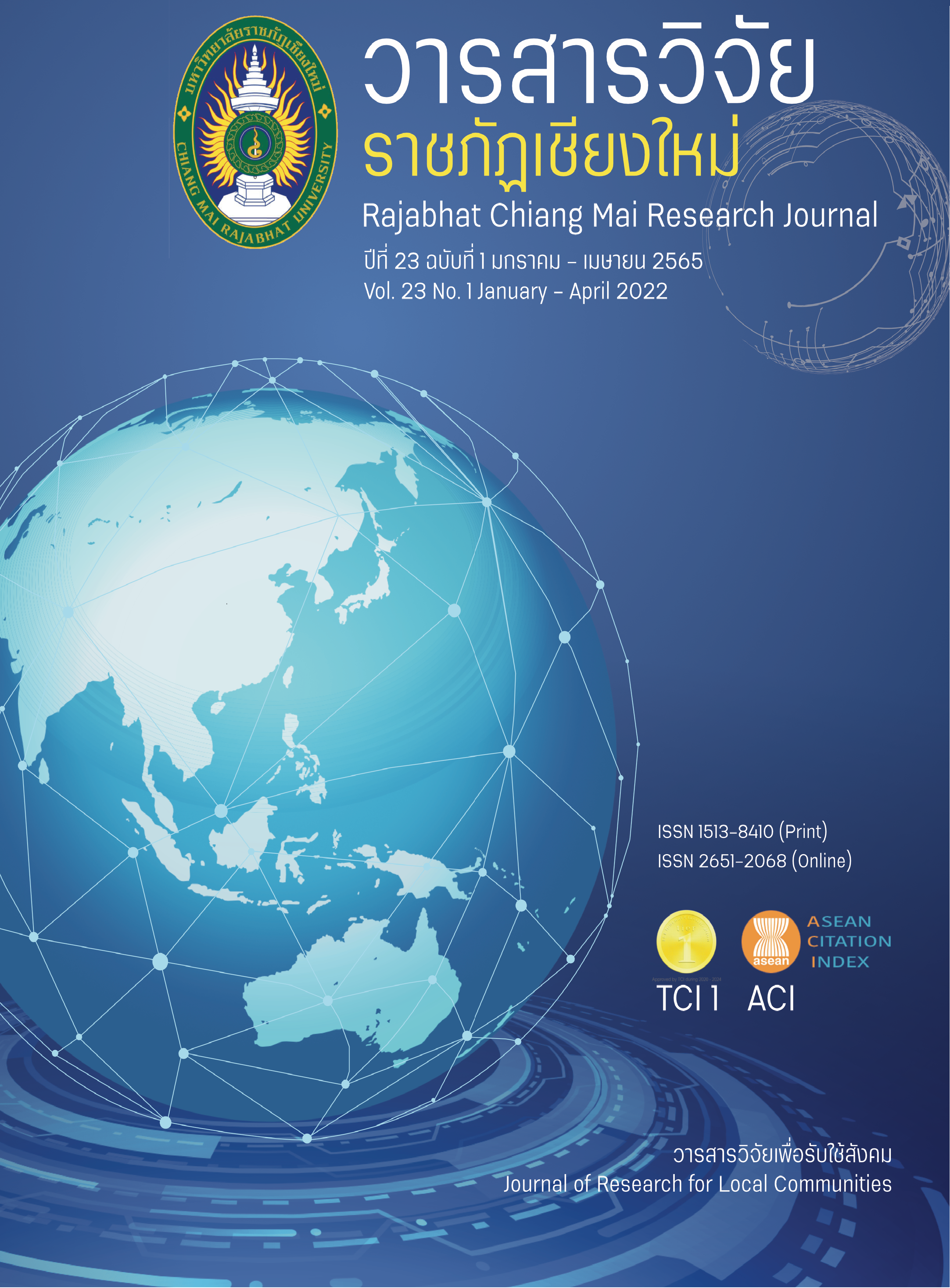The Study of Factors Influencing Education Loan Granting and Repayment at Rajabhat Universities in Northern Thailand
DOI:
https://doi.org/10.14456/rcmrj.2022.250542Abstract
The purposes of this research (1) study of factors affecting student loan borrowing at Rajabhat University in the northern region of Thailand. (2) study the factors affecting student loan repayment of Rajabhat University students in the northern region of Thailand. (3) To prepare recommendations for the management of the Rajabhat University Education Loan Fund in the northern region of Thailand. In the study of factors affecting student borrowing, the variables used in the study consisted of Number of Students Borrowing for Education (QLOAN) GPA of Students Before Education Loan (GAP) Domicile of Students (DOMI) Number of Siblings Attended School (NUMSC) Subjects Studied (CURR) Father's Occupation ( F.OCC), maternal occupation (M.OCC), family income (EARN) and father and mother's marital status (MARRY). In the study of factors affecting student loan repayment variables used in The study consisted of Loan Payments (REPAY), Perceived Loan Payments (AWA), and Student Monthly Income (INC) Information on Loan Payments (INFOR), Understanding Borrowing and Repayment Criteria (UND) Gender (SEX) and marital status (STA).
From the results of the study, it was found that the grade point average before applying for the loan (GPA) and domicile (DOMI) variables were statistically related same direction to affecting student loan borrowing. In addition DOMI, CURR, NUMSC and GAP had a statistically significant direct relationship to QLOAN. Similarly, the occupation of fathers (F.OCC) and mothers (M.OCC) had a statistically significant correlation with the student's domicile (DOMI). It also found that family income (EARN) had a significant direct effect on the number of siblings attending school (NUMSC). the analysis of factors affecting student loan repayment. results showed that both the INC and AWA variables were statistically related to REPAY. In addition Factors affecting loan repayment (REPAY) are Awareness of Loan Repayment (AWA), with a direct effect on loan repayment (REPAY). Among the factors indirectly affecting loan repayment (REPAY) include information about loan repayment (INFOR) and understanding of borrowing and repayment criteria (UND). Furthermore, the study found that gender (SEX) and marital status (STA) directly affect student monthly income (INC), while student monthly income (INC) does not affect loan payments (REPAY).
Downloads
References
Amara, T. (2001). Factors affecting on loan repayment performance of the Student Loan Fund : A Case Study of Students in higher education institutions in Bangkok. (Master degree, The Graduate School, Kasetsart University). (In Thai)
Ashwin, A. (2008). Role of Education in Reducing poverty. Seminar Articles Conclusion 2007 How to end poverty: Benefits Distribution Competition at Ambassador City Jomtien, Chonburi. (In Thai)
Behrman, J.R., Pollak, R.A., and Taubman, P. (1989). Family Resources, Family Size and Access to Financial for College Education. Journal of Political Economy, 97(1989), 389-491.
Cronbach, L.J. (1990). Essentials of Psychological Testing. (5th ed). New York: Harper and Row Collins.
Kraiyos, P. (2013). “Driving Thai education to Thailand 4.0”. Thai Post, October 14th 2013 :1. (In Thai)
Krejcie. R.V. and D.W. Morgan. (1970). Determing Sample Size for Research Activities. Education and Psychological Measurement, 30, 607-610.
Lueangwongngam, S. (2015). Administration Strategy of SLF loan tracking system. Journal of Education. 26: (3): 217-228. (In Thai)
Ministry of Education. (1999). Student Loans Fund Operating Guide. Bangkok: Religious Affairs Printing Press. (In Thai)
Moore, A. W., Anderson, B., Das, K., & Wong, W. K. (2006). Combining multiple signals for biosurveillance. Handbook of biosurveillance, 235.
National Education Act B.E. (2009). Royal Thai Government Gazette, 116(74), 1-41. (In Thai)
Nuthong, P. (2000). An Analysis of the demand for Student Loan Fund in Thailand. (Master of Economics, Faculty of Graduate Studies Ramkhamhaeng University). (In Thai)
Nutsuchon, I. (2014). Thai kids development on a journey to the future. The Economic and Social Journal, 51(3), 22-30. (In Thai)
Office of The Education Council. (2014). An Analysis of the impact of SLF loan on educational accessibility and quality: A Case Study of Khon Kaen Province. Bangkok: Prikwarn Graphic Co., Ltd. (In Thai)
Office of The Education Council. (2007). An Educational Opportunity of Immigrant, Alien, and Tribal Children. Bangkok: Prikwarn Graphic Co., Ltd. (In Thai)
Parliamentary Budget Office (PBO). (2015). The academic report of the Student Loan Fund. Bangkok: The Secretariat of The House of Representatives. (In Thai)
Ruechupan, S. and Wisarutwong, C. (2001). A Research on SLF Administration Guidelines Report. Bangkok: Office of Education Commission. (In Thai)
Streiner, D. L. (2005). Finding our way: an introduction to path analysis. The Canadian Journal of Psychiatry, 50(2), 115-122.
Student Loans Fund. (2013). Student Loans Fund Operator's Guide.Bangkok: Aroon Printing Part., Ltd. (In Thai)
Suratsawadee, C. (2009). A Study of SLF’s Debt Collection Development Guideline Phitsanulok. (Master degree, Faculty of Social Sciences Naresuan University). (In Thai)
Ziderman, A. (1999). The student loan schemes in Thailand: A review and recommendations for efficient and equitable functioning of the scheme. Bangkok: United Nations Educational Scientific and Cultural Organization.
Downloads
Published
How to Cite
Issue
Section
License
Copyright (c) 2022 Rajabhat Chiang Mai Research Journal

This work is licensed under a Creative Commons Attribution-NonCommercial-NoDerivatives 4.0 International License.
1. Articles, information, content, images, etc published in the “Community and Social Development Journal” are copyrighted by the Community and Social Development Journal, Chiang Mai Rajabhat University. In order to properly distribute the articles through print and electronic media, the authors still hold the copyright for the published articles under the Creative Commons Attribution (CC BY) license, which allows the re-distribution of the articles in other sources. References must be made to the articles in the journal. The authors are responsible for requesting permission to reproduce copyrighted content from other sources.
2. The content of the articles appearing in the journal is the direct responsibility of the article authors. The editorial board of the journal does not necessarily agree with or share any responsibility.














